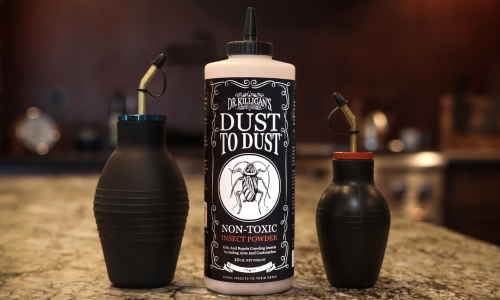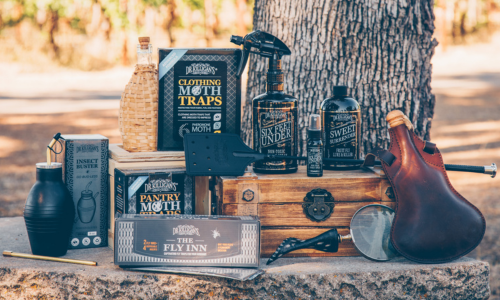The widespread use of chemical pesticides has raised serious concerns about their impact on our health and the environment. From contaminating water sources to harming beneficial insects and wildlife, the repercussions are far-reaching.
How then can we manage pests effectively without compromising the health of our environment, our loved ones, and our homes?
This pressing question forms the core of our mission at Dr. Killigan's. We are wholeheartedly committed to pioneering solutions in eco-friendly pest management that not only promise effectiveness but also safeguard the planet.
Join us as we unveil the top 9 eco-friendly pest management methods, a testament to our dedication to sustainability and health. Discover how you can maintain a pest-free home in perfect harmony with nature.
1. Prevention: The first line of defense

Preventing pests from entering your home is the cornerstone of eco-friendly pest management. By making your space less appealing to pests, you significantly reduce the need for interventions later. Here are some effective prevention strategies:
- Seal entry points: Regularly inspect your home for cracks, crevices and other openings. Use caulk and weatherstripping to seal these potential entry points.
- Install proper screens: Ensure windows and doors are fitted with tight-fitting screens to keep flying and crawling pests at bay.
- Maintain cleanliness: A clean home is less attractive to pests. Regular vacuuming, dusting and decluttering can significantly deter pest invasions by eliminating food sources and hiding spots.
2. Beneficial insects: Allies in your garden
Incorporating beneficial insects into your garden is a remarkable strategy for eco-friendly pest management. Ladybugs, aphid lions and assassin bugs are natural predators that play a crucial role in controlling pest populations. These helpful insects feast on common garden nuisances, including aphids, mites and caterpillars, fostering a balanced ecosystem without the need for harsh chemical interventions.
- Ladybugs are celebrated for their appetite for aphids, helping to protect your plants from these sap-sucking pests.
- Aphid lions, the larval stage of lacewings, are voracious eaters of a wide range of pests, providing broad-spectrum pest management.
- Assassin bugs, known for their predatory skills, target a variety of insects, ensuring your garden remains healthy and thriving.
3. Dust to Dust: Harnessing the power of essential oils with silica support

Dr. Killigan’s Dust to Dust Plant-Powered Insect Powder combines the powerful pest-repelling properties of peppermint and rosemary essential oils with silica as a supportive ingredient. These essential oils inhibit insects' mental abilities while drying out their exoskeleton.
Silica absorbs moisture and thereby aids in the desiccant process, which complements the essential oils' actions. This strategic combination ensures Dust to Dust is not only safe for use around humans and pets but also a formidable barrier against a variety of household pests.
Reading recommendation: For a deeper understanding of silica's dual role in pest deterrence and plant health, explore “How silica strengthens plants”.
4. Six Feet Under: A non-toxic solution
Dr. Killigan’s Six Feet Under Plant-Powered Insect Spray is an exemplar of eco-friendly pest management. Formulated with a blend of essential oils including cinnamon and clove, this potent spray targets pests without the use of harsh chemicals. It's designed to be safe for use around pets and children.
This spray acts quickly to eliminate ants, cockroaches, fleas, and more on contact, while also being biodegradable and environmentally responsible. Whether you're dealing with indoor invaders or outdoor nuisances, Six Feet Under provides an effective, non-toxic solution for maintaining a pest-free home.
5. Companion planting: Strategic gardening
Companion planting harnesses the natural pest-repelling properties of certain plants when placed strategically near each other, promoting garden health, fostering biodiversity and reducing the reliance on chemicals. Here are some effective examples:

- Marigolds act as a natural deterrent against nematodes and tomato hornworms, making them excellent guardians of your vegetable patch.
- Basil not only adds flavor to your dishes but also keeps flies and mosquitoes at bay with its strong scent.
- Garlic, when planted near roses, can help deter aphids, offering a natural shield against these common pests.
Reading recommendation: Read “5 bad bugs in your garden this fall” for practical strategies—including identification of 5 bad bugs, the plants they target, the damage they cause, and eco-friendly elimination methods.
Fact: Basil plants are known to have natural fly-repellent properties and can help keep flies (and mosquitoes) away, as flies detest the strong scent of basil leaves.
6. Physical barriers: Keeping pests at bay
Physical barriers, such as copper tape for slugs and bird netting, provide a non-toxic way to protect your plants from pests. These barriers prevent pests from reaching your plants without harming them, offering a simple yet effective solution.
7. Essential oils: Potent and pleasant
Certain essential oils —such as peppermint, lavender, and cinnamon— are known for their pest-repelling properties. These oils can be diluted and sprayed in areas prone to pests or used in diffusers to create an unwelcoming environment for them.
Reading recommendation: For guidance on utilizing essential oils, delve into “How to repel ants with essential oils” and “What are the best essential oils for insect and bug bites?”. (This second article includes a DIY soothing peppermint roller recipe!)
8. Soap and water: A straightforward approach
A mild solution of soap and water can be an effective pesticide against a variety of soft-bodied pests, including aphids, spider mites and whiteflies. The soap disrupts the pests' cell membranes, causing them to dehydrate and die. This method is safe for use on plants and around humans and pets.
Recommended reading: For additional information on creating a soap and water mixture and other affordable, non-toxic pest control solutions —like a natural DIY ant repellent and a surface cleaner recipe—, see "What are affordable non-toxic pest control solutions?"
9. Sweet Surrender: Dr. Killigan's approach to fruit fly management
For tackling fruit flies within your home, Dr. Killigan's Sweet Surrender Fruit Fly Trap is a non-toxic and impressively effective approach. This trap employs a proprietary blend of vinegar, sucrose and citrus, expertly designed to simulate the enticing scent of fermenting fruit. This lures fruit flies into a container they cannot escape from.
Specifically intended for indoor use, Sweet Surrender is not only a convenient option but also an eco-friendly one. It is reusable and the jar and lid, made from PET (Polyethylene Terephthalate), are highly recyclable. Deploy these traps in your kitchen or any area plagued by fruit flies for an effective, chemical-free solution to maintain a pest-free environment.
Take action: Embrace eco-friendly pest management with Dr. Killigan's

As we conclude our journey through the top eco-friendly pest management methods, we invite you to take a meaningful step towards a healthier, more sustainable approach to managing pests.
Dr. Killigan's is at the forefront of offering solutions that not only respect the well-being of our planet but also ensure the safety of your loved ones and the sanctity of your home. We encourage you to explore our range of eco-friendly products and incorporate these effective methods into your pest management routine.
Together, let's commit to protecting our homes and the environment from pests, without resorting to harmful chemicals. Start making a difference today by choosing Dr. Killigan's for your pest management needs.





















